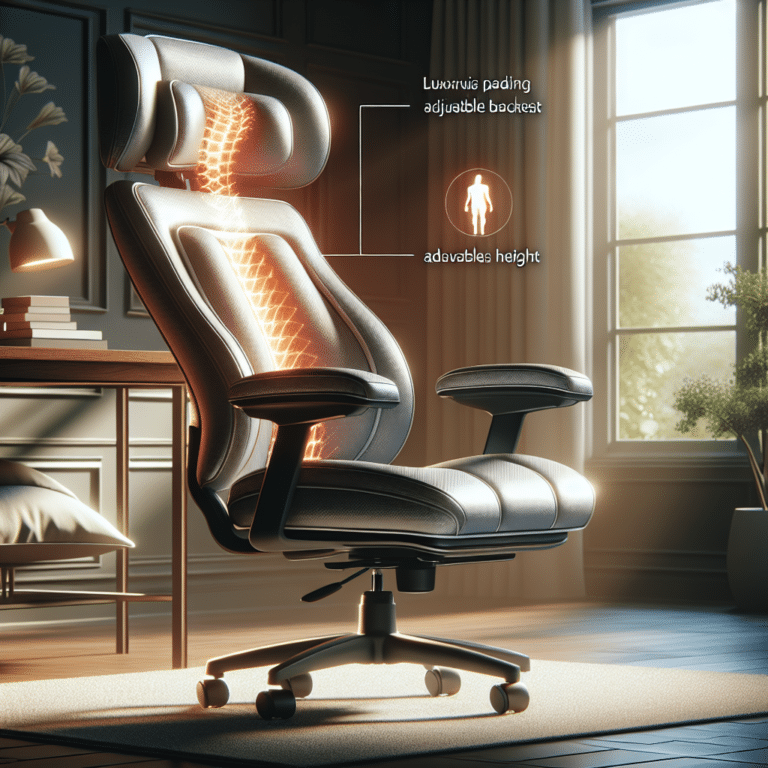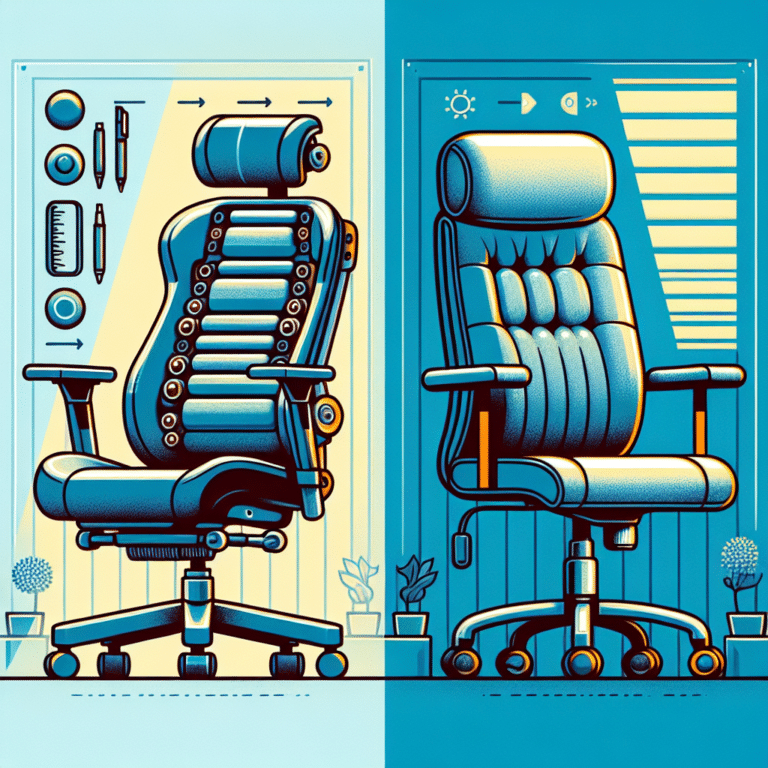Common Mistakes To Avoid When Using An Ergonomic Chair
Using an ergonomic chair can greatly improve your posture and comfort while working, but it’s important to use it correctly to fully reap the benefits. In this article, we will highlight some common mistakes that people often make when using an ergonomic chair, and provide you with simple tips to avoid them. By following these suggestions, you can ensure that you are getting the most out of your ergonomic chair and maintaining a healthy and supportive seating position throughout the day.
Neglecting Chair Adjustments
When it comes to using an ergonomic chair, one of the most common mistakes people make is neglecting to adjust its various features to their specific needs. Many individuals simply sit down without making any adjustments, assuming that the chair is already set up correctly for them. However, failing to make proper chair adjustments can lead to discomfort and even potential long-term health issues.
Failing to Adjust Seat Height
One of the key adjustments that often gets overlooked is seat height. The height of your chair should be set in a way that allows your feet to rest flat on the floor or on a footrest. When your feet are dangling or unsupported, it can put unnecessary strain on your lower back and legs. By adjusting the seat height, you can ensure that your body is properly aligned and supported.
Ignoring Backrest Angle Customization
Another common mistake is ignoring the ability to customize the backrest angle of your chair. The backrest angle should be adjustable to accommodate your natural sitting posture and provide proper support for your spine. By neglecting this adjustment, you may find yourself slouching or leaning forward, both of which can lead to poor posture and back pain over time.
Not Adjusting Armrests
Armrests are often an overlooked feature of ergonomic chairs, but they can play a crucial role in providing support and reducing strain on your arms, shoulders, and neck. Adjusting the height and width of the armrests can help you maintain proper arm positioning, allowing your arms to rest comfortably while you work. Neglecting to adjust the armrests can result in discomfort and potential musculoskeletal issues.
Overlooking the Importance of Seat Depth Adjustment
The depth of your chair seat is another adjustable feature that should not be ignored. The seat depth should be set in a way that provides adequate support for your thighs, without causing pressure points or cutting off circulation. If the seat is too shallow, it can cause discomfort in the back of your thighs, while a seat that is too deep can lead to poor posture and lower back pain. Taking the time to adjust the seat depth can greatly enhance your sitting experience.
Avoiding Footrest Usage When Necessary
If your feet are unable to comfortably reach the floor when sitting in your ergonomic chair, it is essential to use a footrest. Neglecting to utilize a footrest can result in your feet dangling or being unsupported, leading to strain on your lower back and legs. By using a footrest, you can ensure that your feet are properly supported, promoting better posture and reducing the risk of discomfort or injury.
Improper Sitting Posture
In addition to neglecting chair adjustments, another common mistake when using an ergonomic chair is adopting improper sitting postures. While ergonomic chairs are designed to promote good posture, it is still essential to maintain proper sitting positions to fully reap the benefits of these chairs.
Slouching or Leaning Forward Excessively
One of the most detrimental sitting habits is slouching or leaning forward excessively. This posture can put undue strain on your spine, leading to back pain and muscle tightness. To avoid this, it’s important to sit back in your chair and engage the backrest for proper support. Keep your shoulders relaxed and your spine aligned. By maintaining an upright posture, you can reduce the risk of developing postural problems and discomfort.
Crossing Legs or Sitting Asymmetrically
Crossing your legs or sitting in an asymmetrical position might feel comfortable in the short term, but it can lead to imbalances in your posture and put strain on your hips and lower back. It’s important to sit with both feet flat on the floor or a footrest, ensuring equal weight distribution on both sides of your body. By keeping your legs uncrossed and your hips aligned, you can minimize the risk of developing musculoskeletal issues related to poor sitting posture.
Allowing a Gap Between Back and Backrest
When sitting in an ergonomic chair, it’s crucial to have proper contact between your back and the backrest. Allowing a gap between your back and the backrest can result in decreased support and increased strain on your spine. To achieve optimal support, adjust the backrest to fit the natural curvature of your spine and maintain consistent contact throughout your sitting session. This will help reduce the risk of back pain and promote better posture.
Dangling Feet Instead of Flat Placement on Floor or Footrest
Dangling your feet instead of placing them flat on the floor or a footrest can lead to poor posture and strain on your lower back and legs. It is essential to ensure that your feet are supported to maintain proper alignment and reduce the risk of discomfort. If your chair height does not allow for proper foot placement, consider using a footrest to achieve the correct positioning. By keeping your feet flat or supported, you can improve your sitting posture and prevent unnecessary strain on your body.
Disregarding Chair’s Ergonomic Features
Ergonomic chairs are designed with specific features to enhance comfort, promote good posture, and reduce the risk of musculoskeletal issues. However, many individuals overlook these features, failing to take advantage of the full potential of their chairs.
Not Using Lumbar Support
Lumbar support is a crucial feature of ergonomic chairs, as it helps maintain the natural curvature of your lower spine and supports the lumbar region. Unfortunately, many individuals neglect to utilize this feature, resulting in poor posture and increased strain on the lower back. Adjusting the lumbar support to fit the natural curve of your lower back can provide additional support and help alleviate discomfort.
Ignoring Tilt Tension for Controlled Reclining
Most ergonomic chairs come with a tilt tension adjustment, allowing you to control the amount of resistance when reclining. Ignoring this feature or failing to adjust it according to your preference can lead to discomfort and poor posture. Adjusting the tilt tension to a level that allows you to recline comfortably while maintaining proper support can promote relaxation and reduce the risk of strain on your back and neck.
Not Utilizing Chair’s Swivel Function
The swivel function of an ergonomic chair allows you to rotate and move around your workspace without straining your body. Unfortunately, many people overlook this feature, limiting their mobility and potentially causing them to twist or reach awkwardly. Remember to take advantage of the chair’s swivel function, allowing you to move effortlessly and maintain better ergonomics throughout your workday.
Not Leveraging the Headrest Adjustments
If your ergonomic chair is equipped with a headrest, it’s important not to overlook its adjustments. The headrest can provide support for your neck and head, helping alleviate strain and promoting better posture. Adjust the headrest to a comfortable height and angle so that it aligns properly with your neck and head, reducing the risk of neck pain and discomfort.

Incorrect Desk and Chair Alignment
Proper alignment between your chair and desk is crucial for maintaining good posture and reducing strain on your body. Unfortunately, many individuals make mistakes when setting up their workspace, leading to discomfort and potential health issues.
Placing Chair Too High or Low Relative to Desk
Incorrect chair height in relation to your desk can result in poor posture and discomfort. If your chair is too high, your feet may not touch the floor or footrest, causing strain on your legs and lower back. On the other hand, if the chair is too low, you may have to strain your arms and shoulders to reach your keyboard and mouse. Adjust the chair height so that your feet are flat on the floor or footrest, and your arms are at a comfortable angle when typing.
Incorrect Monitor Height Leading to Neck Strain
The height of your monitor plays a significant role in your sitting posture. If your monitor is positioned too low, it can cause you to tilt your head and neck downward, leading to neck strain. Conversely, if the monitor is too high, it can cause you to tilt your head backward, also resulting in unnecessary strain. Position your monitor at eye level, ensuring that you can see the screen without having to strain your neck or adjust your sitting position.
Inadequate Distance Between Chair and Desk
The distance between your chair and desk is important for maintaining proper posture and reducing strain on your upper body. If the distance is too far, you may find yourself reaching forward, stressing your arms and shoulders. Conversely, if the distance is too close, you may have to hunch over, causing strain on your neck and back. Ensure that there is enough space between your chair and desk to comfortably accommodate your arms and that you can maintain an upright posture without feeling cramped.
Mismatch of Desk and Chair Styles Impeding Comfort
Using an ergonomic chair with a desk that is not designed for optimal sitting ergonomics can hinder your comfort and posture. It’s important to ensure that your desk and chair are compatible in terms of height and functionality. If you’re using an adjustable chair, make sure your desk can accommodate the various height settings. Similarly, if you have a standing desk, ensure that your chair can be easily adjusted or stored to prevent interference when you switch between sitting and standing.
Too Much or Too Little Use of Chair Adjustability
Finding the right balance in utilizing the adjustability features of your ergonomic chair is crucial for optimal comfort and support. Some individuals tend to over-adjust, making frequent changes without considering the impact on their posture and ergonomics, while others underutilize the features, missing out on the benefits they offer.
Over-adjusting Chair Settings
Over-adjusting your chair settings can lead to constant changes and potential loss of focus. While it’s important to make necessary adjustments to achieve proper ergonomics, constantly tweaking can become a distraction. Once you have found the right settings for your body, stick to them and only make minor tweaks if needed. This will help maintain consistency and allow you to focus on your tasks without unnecessary interruptions.
Underutilizing Adjustment Features
On the other hand, underutilizing the adjustment features of your chair means missing out on the potential benefits they offer. Take the time to familiarize yourself with the various adjustments your chair provides, such as seat height, backrest angle, and armrest positioning. Experiment with different settings to find the most comfortable and supportive positions for your body. By fully leveraging the adjustability features, you can optimize your sitting experience and minimize the risk of discomfort or strain.
Not Storing Custom Settings If Available
Many ergonomic chairs offer the ability to store custom settings, allowing you to quickly readjust the chair to your preferred positions. However, some individuals fail to take advantage of this feature, often forgetting their personalized settings or neglecting to save them. If your chair has a memory function, be sure to take the time to set and save your custom positions. This will save you time and effort when readjusting your chair in the future.
Adjusting Without Regard to Task Ergonomics
While it’s important to set up your chair for overall comfort, it’s also essential to consider the specific tasks you will be performing. Different tasks may require slight adjustments to promote better ergonomics. For example, if you are using a computer, ensure that your chair is properly adjusted to support your arms and wrists while typing. If you are doing focused reading or writing tasks, adjust the angle of your backrest to optimize support and reduce strain on your back. By considering task ergonomics, you can enhance your productivity and reduce the risk of discomfort.
Poor Maintenance of Ergonomic Chair
Neglecting the maintenance of your ergonomic chair can have a detrimental impact on its functionality and your sitting experience. Regular cleaning and addressing any issues promptly are essential to maintain the chair’s performance and longevity.
Ignoring Regular Cleaning
Dust, dirt, and spills can accumulate on your chair over time, affecting its appearance and functionality. Neglecting regular cleaning can lead to a buildup of allergens and bacteria, potentially causing health issues and reducing the lifespan of your chair. Clean your chair regularly using a soft cloth, mild detergent, and water, following the manufacturer’s cleaning guidelines. Be sure to clean all areas, including the seat, backrest, armrests, and base, to maintain a clean and hygienic sitting environment.
Neglecting Wear and Tear Inspection
With regular use, your ergonomic chair may experience wear and tear. It’s important to regularly inspect your chair for any signs of damage, such as loose screws, worn-out padding, or broken components. Ignoring these issues can lead to further damage and compromise the chair’s stability and comfort. Perform regular inspections and address any wear and tear promptly to ensure the continued functionality of your chair.
Not Addressing Squeaks and Wobbles Promptly
If your chair starts to squeak or wobble, it’s crucial to take action promptly. Ignoring these issues can be both annoying and indicative of underlying problems with the chair’s structure or mechanisms. Tighten loose screws, lubricate moving parts, or contact the manufacturer for assistance if needed. By addressing these issues promptly, you can prevent further damage and maintain the stability and performance of your chair.
Overlooking Manufacturer’s Maintenance Guidelines
Every ergonomic chair comes with specific maintenance guidelines provided by the manufacturer. These guidelines outline recommended cleaning methods, maintenance practices, and any specific considerations for your chair’s model. It’s important to read and follow these guidelines to ensure proper maintenance and prevent voiding any warranty. By adhering to the manufacturer’s instructions, you can prolong the life of your chair and maintain its optimal performance.
Choosing the Wrong Chair Size
Selecting the wrong chair size for your body dimensions is a common mistake that compromises comfort and support. It’s important to choose a chair that is suited for your body size and proportions to fully enjoy the benefits of an ergonomic design.
Selecting a Chair Not Suited for Body Dimensions
Ergonomic chairs come in various sizes to accommodate different body types. Failing to choose a chair that is suited for your body dimensions can result in inadequate support and discomfort. Consider the chair’s height, width, and backrest size in relation to your own measurements. If possible, try out different chair sizes or consult the manufacturer’s sizing guide to ensure a proper fit.
Ignoring Weight Capacity and Chair Dimensions
Weight capacity is an important consideration when selecting an ergonomic chair. Choosing a chair that exceeds its weight capacity can compromise its stability and durability, potentially leading to accidents or structural issues. Additionally, ignoring the chair’s dimensions can result in poor ergonomics, as it may not provide adequate support and proper alignment for your body. Always check the weight capacity and dimensions of a chair before purchasing to ensure it can properly accommodate your needs.
Not Testing Chair Comfortably Before Purchase
When shopping for an ergonomic chair, it’s crucial to test its comfort and functionality before making a purchase. Sitting in a chair and evaluating its fit, support, and adjustability can help you determine if it’s the right choice for you. Take the time to sit in different chairs, adjust their settings, and assess how they feel on your body. Pay attention to any pressure points, discomfort, or lack of support. By testing chairs before purchasing, you can make an informed decision and find the chair that best suits your needs.
Overlooking Chair Scalability for Different Users
If multiple people will be using the same ergonomic chair, it’s important to consider its scalability. Chairs with adjustable features, such as seat height, armrest positioning, and backrest angle, can accommodate different users and their unique needs. Overlooking this scalability can result in an uncomfortable sitting experience for different individuals. Ensure that the chair can be easily adjusted to fit various body sizes and proportions, allowing everyone to benefit from its ergonomic design.
Inadequate Adjustment Education
Understanding how to properly adjust your ergonomic chair is essential for maximizing its benefits. Many individuals neglect to educate themselves on the chair’s adjustment features, resulting in suboptimal sitting experiences.
Not Reading the User Manual
The user manual provided with your ergonomic chair contains valuable information on how to adjust and use the chair correctly. Neglecting to read the manual means missing out on important instructions and tips that can enhance your sitting experience. Take the time to familiarize yourself with the manual, understanding the chair’s adjustment mechanisms and their intended purposes. This will empower you to fully optimize your chair’s functionality.
Lack of Training on Adjustment Features
In workplaces where ergonomic chairs are provided, employees may not receive proper training on how to adjust and utilize the chair’s features. This lack of education can result in employees not fully understanding the chair’s capabilities and how to set it up correctly for their needs. Employers should prioritize training sessions or workshops that educate employees on the proper use of ergonomic chairs, including how to make necessary adjustments, maintain good posture, and prevent discomfort.
Over-reliance on Preset Configuration
Some ergonomic chairs come with preset configurations designed to cater to a broad range of users. While these presets can serve as a starting point, it is important to remember that everyone’s body is unique, and individual adjustments may be necessary. Over-relying on preset configurations without making personal adjustments can result in suboptimal support and discomfort. Take the time to personalize your chair’s settings based on your own body dimensions and sitting preferences.
Not Seeking Expert Guidance When Needed
If you are unsure about how to properly adjust your ergonomic chair or have specific concerns about your sitting posture, it’s important to seek expert guidance. Ergonomics professionals or occupational health experts can provide valuable insight and guidance tailored to your specific needs. They can assess your sitting posture, evaluate your chair setup, and offer recommendations to optimize your ergonomics and reduce the risk of discomfort or injury. Don’t hesitate to reach out for professional assistance when needed.
Lack of Dynamic Sitting Practices
Sitting in one position for extended periods can lead to muscle fatigue, stiffness, and decreased productivity. Embracing dynamic sitting practices is crucial for promoting better blood circulation, reducing the risk of musculoskeletal issues, and maintaining focus throughout the day.
Remaining in the Same Position for Too Long
One of the most significant mistakes individuals make when using an ergonomic chair is staying in the same position for prolonged periods. This static sitting can strain your muscles and increase the risk of developing musculoskeletal issues. Incorporate movement into your sitting routine by taking short breaks to stand, stretch, or walk around. Aim to change your sitting posture every 30 minutes to prevent muscle fatigue and promote better circulation.
Not Taking Regular Breaks to Stretch and Move
Regular breaks are essential for maintaining healthy sitting habits. Use your breaks as an opportunity to stretch and move your body. Stand up, walk around, and perform simple stretches to relieve muscle tension and improve blood flow. Incorporating these movements into your routine can help refresh your mind, increase energy levels, and reduce the risk of stiffness or discomfort.
Underestimating the Benefits of Movement
Movement is essential for keeping your body engaged and preventing the negative effects of prolonged sitting. Don’t underestimate the benefits of small movements while sitting. Shift your weight from side to side, wiggle your toes, and perform gentle upper body stretches to keep your muscles active and prevent stiffness. Engaging in these small movements throughout the day can help improve circulation, reduce muscle tension, and enhance your overall sitting experience.
Failing to Alternate Postures Throughout the Day
While maintaining good posture is important, it’s also beneficial to alternate between different sitting positions throughout the day. Lean back while reclining, sit upright with proper alignment, or lean forward slightly when performing specific tasks. Changing your sitting positions periodically helps distribute pressure and reduce strain on specific muscles, promoting better overall comfort and reducing the risk of overuse injuries.
Ignoring Environmental Factors
An ergonomic chair is just one component of a productive and comfortable workspace. Ignoring environmental factors, such as lighting, temperature, and workspace arrangement, can affect your overall sitting experience and well-being.
Not Adapting Chair Usage to Room Lighting and Temperature
Room lighting and temperature can significantly impact your comfort and productivity. Sitting in a dimly lit room or under harsh lighting can strain your eyes and decrease overall visual comfort. Similarly, working in an environment that is too hot or too cold can be distracting and detrimental to your focus. Adjust the lighting in your workspace to reduce glare and ensure adequate illumination. Also, maintain a comfortable temperature by using fans, heaters, or adjusting the thermostat to create an optimal working environment.
Disregarding Workspace Ergonomic Arrangement
The arrangement of your workspace plays a crucial role in your overall sitting experience. Disregarding ergonomic principles when arranging your desk, keyboard, mouse, and other accessories can result in discomfort and strain. Ensure that your workstation promotes a neutral posture, with your keyboard and mouse positioned at a comfortable height and distance. Place frequently used items within easy reach to prevent unnecessary stretching or reaching. By optimizing your workspace arrangement, you can enhance your sitting comfort and reduce the risk of discomfort or musculoskeletal issues.
Not Pairing Chair With Adequate Desk Accessories
The accessories you pair with your ergonomic chair can further enhance your sitting comfort and productivity. Neglecting to use accessories such as an adjustable keyboard tray, monitor stand, or document holder can limit your ergonomic setup. These accessories can help maintain proper alignment and reduce strain on your wrists, neck, and eyes. Consider investing in the appropriate desk accessories that complement your chair and promote a more comfortable and efficient work environment.
Failure to Adjust Chair Based on Flooring Type
The type of flooring in your workspace can affect the stability and functionality of your ergonomic chair. Failing to adjust your chair based on the flooring type can result in instability or uneven support. If you have carpeted flooring, adjust the chair’s casters to provide optimal stability and prevent sinking. On hard flooring surfaces, ensure that the chair’s casters roll smoothly without causing excessive resistance. Adapting your chair to the specific flooring type can enhance your sitting experience and prevent unnecessary strain on your body.
In conclusion, using an ergonomic chair properly involves more than simply sitting down. Neglecting chair adjustments, adopting improper sitting postures, disregarding the chair’s ergonomic features, incorrect desk and chair alignment, inadequate adjustment education, poor maintenance, choosing the wrong chair size, lack of dynamic sitting practices, and ignoring environmental factors are all common mistakes to avoid. By addressing these areas and incorporating proper ergonomics into your sitting routine, you can enhance your overall comfort, productivity, and well-being. Remember to regularly adjust your chair to fit your body’s unique needs and utilize the chair’s features to their full potential. Maintaining good posture, taking breaks to stretch and move, and creating a supportive work environment will further contribute to a healthy and enjoyable sitting experience.








